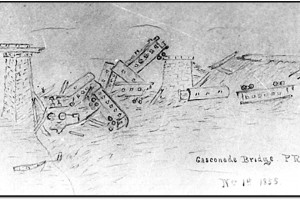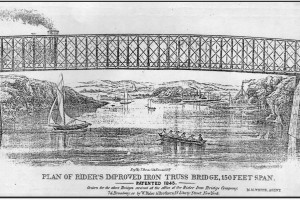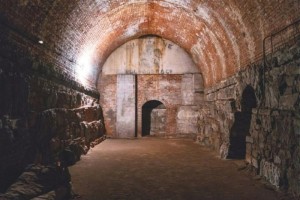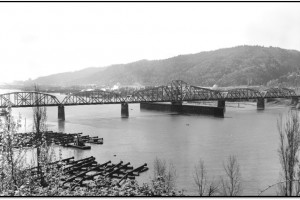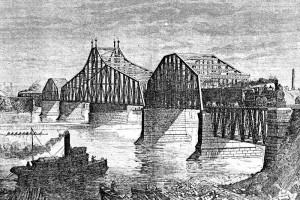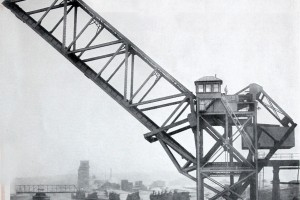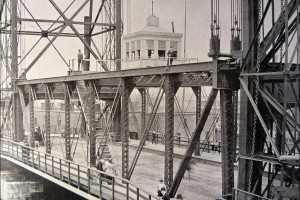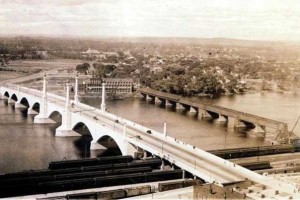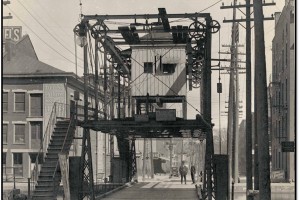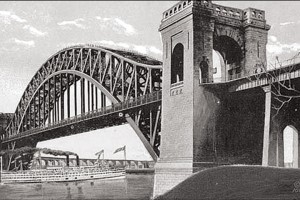The Pacific Railroad was chartered in Missouri in 1849 to build a railroad from St. Louis to the Pacific Ocean. Due to financing problems and outbreaks of cholera, construction did not begin until 1851 with a groundbreaking at which prominent citizens of St. Louis turned out to celebrate the start of construction of the line. It included speeches, a national salute, and the reading of a poem written for the moment in history. …
Review Category : Historic Structures
This is the first in a series of articles on bridge failures in the United States. While failures are always newsworthy, especially if there is a loss of life, they are also lessons for bridge engineers to learn from. Failures, while traumatic, can be good teachers. Over the coming issues, this series will describe 20 failures, some of which you may have heard of. The earliest failure was in 1850 and the most recent in 1987. …
The landmark Gothic-Revival massive granite towers of the Brooklyn Bridge, with their arrays of cable-and-stay structural scheme, developed in the usual way for its era. Commercial East River shipping and ferry operators in the 1860s protested when they foresaw that if the East River Bridge in New York City, proposed by John Roebling (b.1806), was built, it would undercut their highly profitable river businesses. The flourishing river interests organized and put political pressure on the War Department to thwart the proposal. …
Alfred P. Boller’s Thames River Swing Bridge (STRUCTURE, February 2019) remained the longest swing span in the world until J. A. L. Waddell’s Omaha Bridge over the Missouri River in 1893 with its 520-foot span. Waddell would build a bridge in 1903, very similar end-to-end to his 1893 span, with a slightly shorter span. It was not until 1908 that Ralph Modjeski built his Willamette River Swing Bridge in Portland, Oregon, with a 521-foot span and the title of the longest swing bridge was wrested from the Omaha twin swing bridges of Waddell. …
New London, Connecticut, 1889
Alfred P. Boller (STRUCTURE, November 2011) had already designed swing bridges across the Pequannock River, Harlem River, Hudson River, Ft. Point Channel, and the Arthurkill when he was called to be the designer of the longest swing bridge in the United States across the Thames River in Connecticut. …
After graduating from the University of Cincinnati in 1892, Joseph Strauss (STRUCTURE, October 2012) became a draftsman for the New Jersey Steel and Iron Company at Trenton, NJ. At the end of the year, Joseph went to the Lassig Bridge and Iron Company of Chicago for two years, working as a detailer, inspector, estimator, and designer. …
In 1893, John A. L. Waddell (see bio in STRUCTURE, February 2007) designed, based on the designs of Squire Whipple, a lift bridge over the south branch of the Chicago River at South Halsted Street. Plans were made to replace a damaged swing bridge at the site with another swing bridge but the “lake navigation interests” objected, arguing that the old bridge was “always a serious obstruction to navigation.” Their argument was heard by the Corps of Engineers who ruled that they “would not permit him [the Commissioner of Public Works Aldrich] to build any structure which would narrow the water-way to such an extent as would a rotating draw span.” …
Here…is the gateway to Springfield and the towns to the east for almost an entire nation,” proclaimed Massachusetts Governor Channing Cox on August 2, 1922. It was Dedication Day for the new Hampden County Memorial Bridge, which spans the Connecticut River between the City of Springfield and Town of West Springfield in Western Massachusetts. Boston engineers Fay, Spofford & Thorndike, with architects Haven & Hoyt, designed the bridge, deemed a “finely-engineered example of a rare self-supporting arch rib reinforcement technique derived from the Melan tradition” [HAER Ma-114]. …
Utica, New York 1873
The Hotel Street Lift Bridge, constructed in Utica, New York, in 1873, was a first of its kind and a gateway to long-span lift bridges in later years. In the 1850s, the Erie Canal Board adopted Whipple bowstring trusses (STRUCTURE, January 2015) to cross the canal in cities requiring a span of 72 feet, as that was the standard span for the Whipple bowstring. …
Gustav Lindenthal was chief engineer of the New York Connecting Railroad for many years. The length of his section was 3.38 miles long and extended from a point in the Bronx at the intersection with the New Haven Railroad to Stemler Street in Long Island City. The line from north to south crossed the Bronx Kill, ran over Randall’s Island, across the Little Hell Gate, across Wards Island and over the East River at Hell Gate, and then by a long viaduct to the southerly-most point of his Division. The largest of the three bridges on the line was the Hell Gate. …

